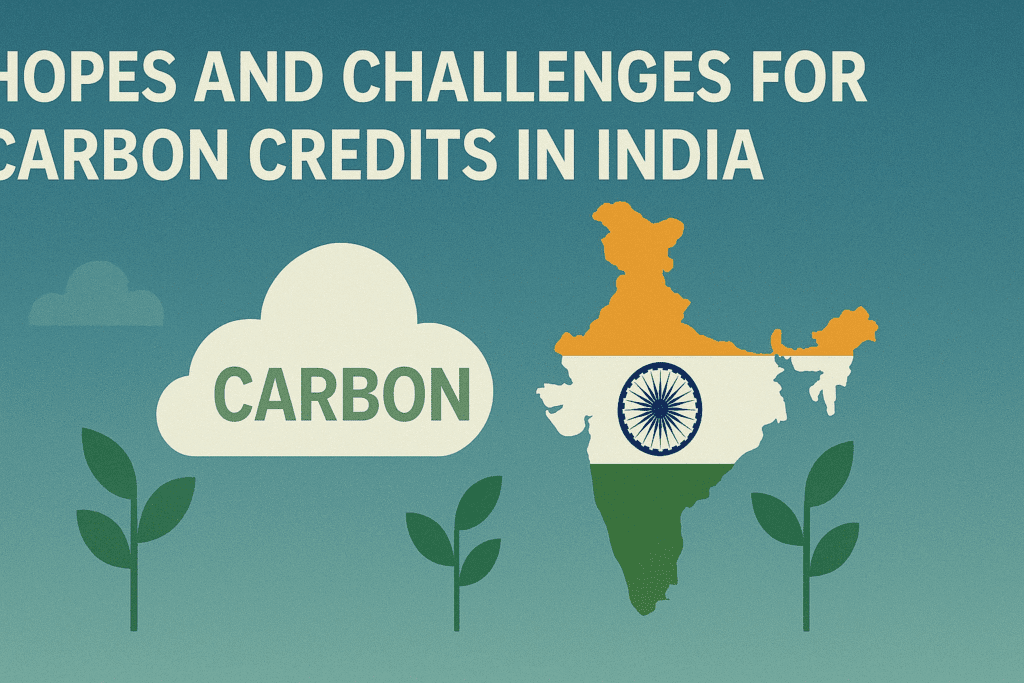India’s journey toward a sustainable future is increasingly intertwined with carbon credits, a mechanism designed to incentivize emission reductions and support global climate goals. As the world’s third-largest emitter, India has committed under the Paris Agreement to reduce the emission intensity of its GDP by 45% from 2005 levels by 2030, while aiming for net-zero by 2070. The Carbon Credit Trading Scheme (CCTS) and the broader Indian Carbon Market (ICM) represent pivotal tools in this endeavor, blending compliance and voluntary elements to drive decarbonization. Yet, while these initiatives hold promise for economic growth and environmental progress, they grapple with significant obstacles, including verification complexities and barriers for small-scale participants. This blog explores the dual facets of hope and challenge in India’s carbon credit landscape as of 2025.
Hopes: Economic Opportunities and Climate Alignment
India’s carbon market is poised for substantial growth, aligning closely with its Paris Agreement obligations. The CCTS, managed by the Bureau of Energy Efficiency (BEE), sets sector-specific emission intensity targets, encouraging industries to adopt low-carbon technologies and earn tradable credits for surpassing reductions. This framework replaces older schemes like Perform, Achieve, and Trade (PAT) and is projected to cover key sectors such as iron and steel, cement, petrochemicals, petrochemicals, and paper by April 2025, encompassing about 15% of national GHG emissions by 2030.
Economically, the market offers a boon: carbon credits could generate up to $1.2 billion in value, attracting green investments and fostering renewable energy adoption. Integration with international mechanisms under Article 6 of the Paris Agreement could enhance liquidity and enable global trading, positioning India as a leader in offsets. Initiatives like the Green Credit Programme and Renewable Energy Certificates (RECs) further amplify hopes, promoting circular economies and sustainable practices in agriculture and forestry.
In agriculture, voluntary carbon markets (VCM) hold potential for sequestering 2.5-3 billion tonnes of CO₂ equivalent through enhanced forest cover, aligning with NDCs. Emerging technologies like blockchain for transparent verification add optimism, potentially preventing fraud and boosting investor confidence. Overall, these developments signal a pathway to not only meet the 45% intensity reduction target but also achieve broader goals like 50% non-fossil fuel power capacity by 2030.
Challenges: Verification, Access, and Regulatory Hurdles
Despite the promise, India’s carbon market faces formidable challenges that could undermine its effectiveness. Verification remains a core issue: outdated Measuring, Reporting, and Verification (MRV) systems lead to inaccuracies in emission tracking, with voluntary markets losing nearly 90% of value in supply chains due to weak oversight. Overestimation in forestry and agriculture projects—highlighted in recent studies—exacerbates risks of greenwashing, eroding trust. Half of India’s forestry initiatives have failed due to community rights disputes, per 2025 reports.
Equitable access for small players is another critical barrier. Micro, Small, and Medium Enterprises (MSMEs) struggle with high compliance costs, limited technical capacity, and inadequate financing, making participation exclusionary. Global inequalities persist, as developing nations like India face hurdles in technology access and resources, with only 0.3% of climate funds reaching local communities. Market liquidity issues, potential oversupply, and price instability—evident in past glitches like the 2021 PXIL incident—further complicate involvement for smaller entities.
Regulatory uncertainties compound these problems. The CCTS launch may slip into 2026 due to complex design challenges, and enforcing targets on financially stressed sectors risks uneven implementation. International factors, such as the EU’s Carbon Border Adjustment Mechanism (CBAM), could impact competitiveness, while domestic issues like land competition and climate disasters threaten permanence. Financing gaps are stark: trillions in investments are needed by 2050, but current international flows fall short, hindered by IP barriers and inadequate support from developed nations.
Future Outlook: Steps Toward a Resilient Market
To realize the hopes of carbon credits, India must prioritize reforms: enhancing MRV transparency, providing subsidies and training for MSMEs, and fostering fair community negotiations. Aligning with global standards under Article 6 and leveraging initiatives like the National Hydrogen Mission could bridge gaps. As 2025 unfolds, with COP30 on the horizon, India’s market could transform challenges into opportunities, driving equitable, low-carbon growth.
In conclusion, while carbon credits offer a beacon for India’s Paris-aligned ambitions, addressing verification and access hurdles is essential to ensure inclusive progress.
References
- Carbon Credits in India: Hopes and Challenges – Drishti IAS – https://www.drishtiias.com/daily-updates/daily-news-editorials/carbon-credits-in-india-hopes-and-challenges (Published: Aug 16, 2025)
- Carbon Market in India Problems & Prospects – https://acr-journal.com/article/download/pdf/1096/ (Published: Aug 15, 2025)
- India’s Long-Term Low-Carbon Development Strategy – UNFCCC – https://unfccc.int/sites/default/files/resource/India_LTLEDS.pdf (Published: Nov 14, 2022)

